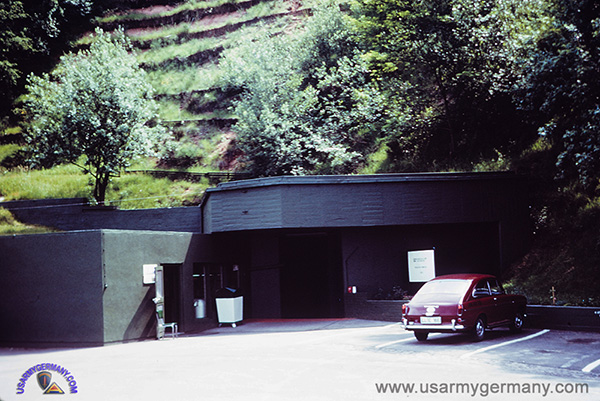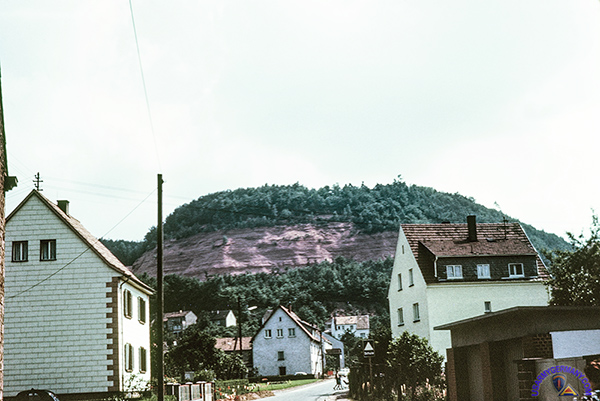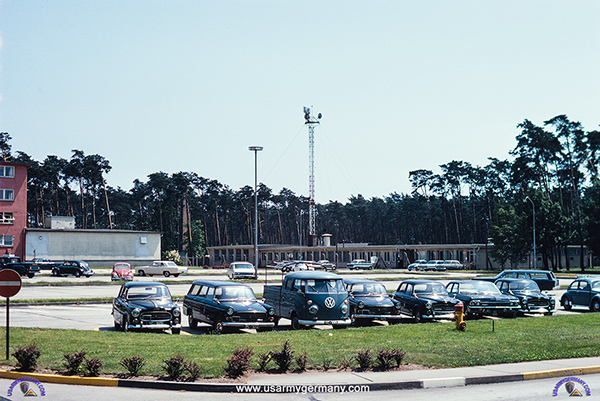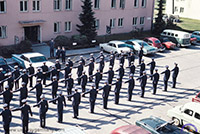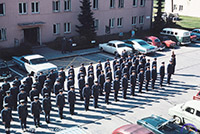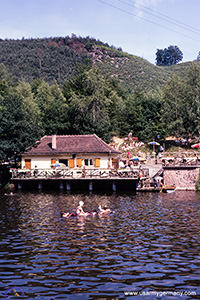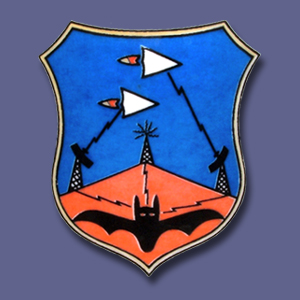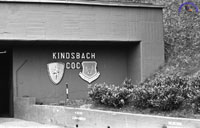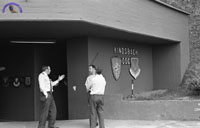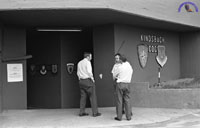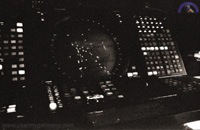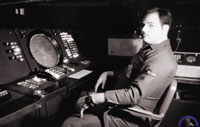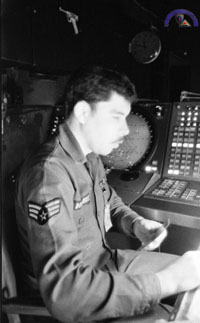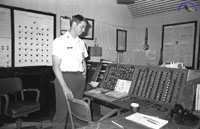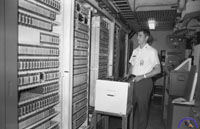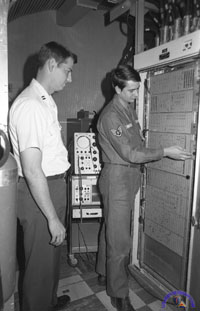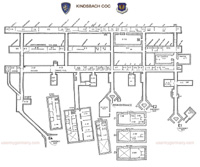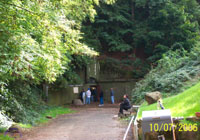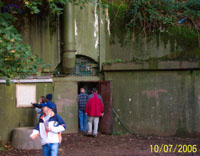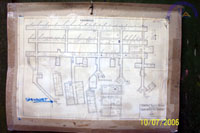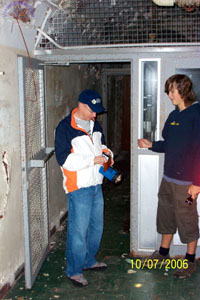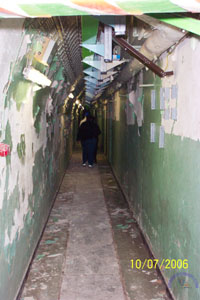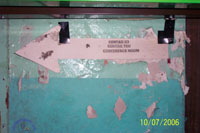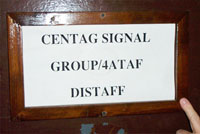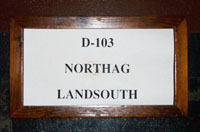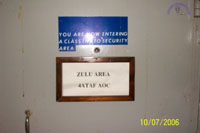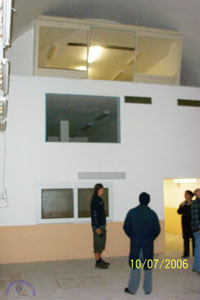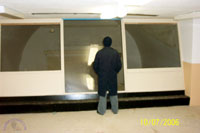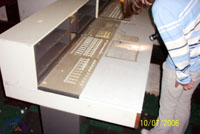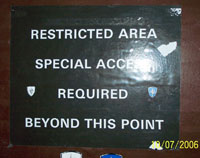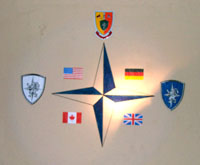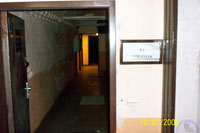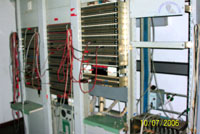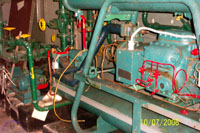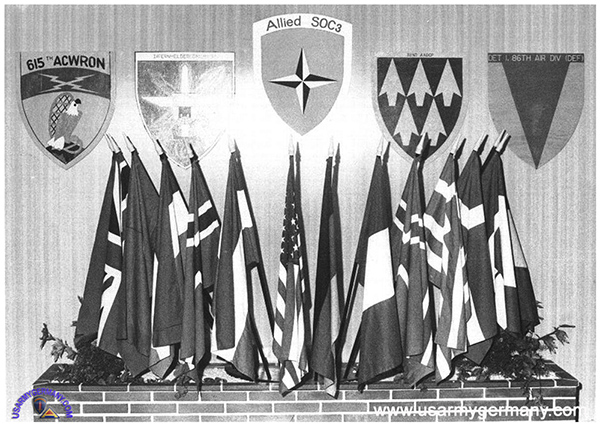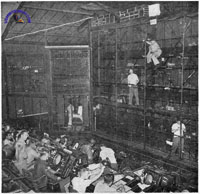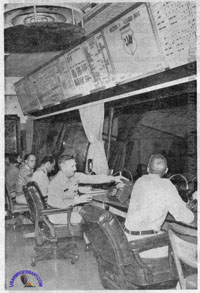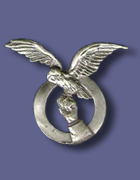Tactical Air Control System |
|||||||||||||||||||||||||||||||||||||||||||||||||||||||||||||||||
|
|||||||||||||||||||||||||||||||||||||||||||||||||||||||||||||||||
| 4th Allied Tactical Air Force | |||||||||||||||||||||||||||||||||||||||||||||||||||||||||||||||||
| (Source: Forty-Five Years of Vigilance for Freedom, United States Air Force in Europe, 1942-1987. HQ USAFE, 1988?; NATO Forces, An Illustrated Reference to their Organization and Insignia, Brian L. Davis, 1988) | |||||||||||||||||||||||||||||||||||||||||||||||||||||||||||||||||
| 4th ATAF On 2 April 1951, USAFE assumed new international responsibilities with the establishment of a NATO organization, Allied Air Forces Central Europe (AAFCE), headquartered at Fontainebleau, France. The USAFE commander assumed a second role as Commander in Chief, AAFCE. The new command was initially made up of the US Twelfth Air Force (the 12th AF had been activated only shortly before, on 21 Jan 1951), the British Air Forces of Occupation, and the 1st French Air Division. USAFE's expanding international responsibilities resulted in more clearly defined tactical force commitments to NATO when the 12th AF was assigned as an operational command of the Fourth Allied Tactical Air Force (ATAF). (AAFCE had organized both ATAFs - Second and Fourth - on 2 April 1952. With the formation of 4ATAF at Landsberg Air Base, the Commander of 12th AF assumed the second job as Commander, 4ATAF. AAFCE placed under the command of 4ATAF the facilities and flying units of the 12th US Air Force, 1st French Tactical Air Corps and the 1st Royal Canadian Air Force Air Division. Twelfth Air Force headquarters, which had been split between Landsberg and Wiesbaden since 1951, was reunited at Ramstein (a portion of Landshtuhl Air Base) on 27 April 1953. During the same time, Headquarters, Fourth Allied Tactical Air Force moved from Landsberg to Trier, Germany. The major functions of Headquarters, USAFE and Twelfth Air Force were consolidated on 10 Nov 1957. The Twelfth at Ramstein Air Base, became USAFE's Advanced Headquarters (ADVON). It included command staff functions, communications, and combat intelligence. At the same time, CINCUSAFE was named Commander, 4ATAF, and the latter unit moved from Trier to Ramstein. (HQ 12th AF would be returned to the States on 1 Jan 1958.) 4ATAF Headquarters opened at Ramstein on 1 July 1958. |
|||||||||||||||||||||||||||||||||||||||||||||||||||||||||||||||||
|
|||||||||||||||||||||||||||||||||||||||||||||||||||||||||||||||||
| (Source: Welcome booklets for the 86th FIW (Landstuhl AB) and 7030th S (Ramstein AB), both around 1956-58) | |||||||||||||||||||||||||||||||||||||||||||||||||||||||||||||||||
|
|||||||||||||||||||||||||||||||||||||||||||||||||||||||||||||||||
| (Source: USAREUR Annual Historical Report, 1953-54) | |||||||||||||||||||||||||||||||||||||||||||||||||||||||||||||||||
| In December 1952 Twelfth Air Force had requested CINCUSAREUR to approve an amendment to an agreement by U.S. and French military representatives on 2 March 1951 pertaining to the exchange of facilities and the stationing of troops within their respective zones. The proposed amendment, submitted by the Commanding General, Twelfth Air Force, and approved by the Commanding General, First Air Division, would transfer the Forces auxiliaires du Genie (FAG or Engineer Auxiliary forces), barracks at Trier, Germany, from French to U.S. control and provide for a future agreement on the utilization of the Trier-Euren airfield. In exchange, Twelfth Air Force would transfer DM 2,000,000 of its GFY 1953 budget to the French, to pay the cost of relocating French troops stationed at the FAG barracks. Twelfth Air Force would make the installation available for use as the peacetime headquarters of the Fourth Tactical Air Force (FOURATAF), an international headquarters under the operational control of Headquarters, AIRCENT. Located at Landsberg, Germany, AIRCENT headquarters in late 1952 consisted of 98 United States, 5 French and 2 Canadian personnel. In January 1953 CINCUSAREUR agreed to the transfer of the FAG barracks in Trier to Twelfth Air Force. |
|||||||||||||||||||||||||||||||||||||||||||||||||||||||||||||||||
| 1955 | |||||||||||||||||||||||||||||||||||||||||||||||||||||||||||||||||
| 1956 | |||||||||||||||||||||||||||||||||||||||||||||||||||||||||||||||||
| (Source: STARS & STRIPES, Jan 18, 1956) | |||||||||||||||||||||||||||||||||||||||||||||||||||||||||||||||||
| 4th Allied Tactical Ar Force (4th ATAF) is headquartered at Trier, Germany. Commander of 4th ATAF is Maj Gen Robert M. Lee, who also is commander of the US 12th Air Force with headquarters at Ramstein, Germany. 12th Air Force comprises the US elements of 4th ATAF. On the 12th AF side, Gen Lee is assisted by Brig Gen William M. Gross, deputy commander of 12th AF. Gen Gross takes over the 12th AF when Gen Lee is actively assuming command of 4th ATAF. On the 4th ATAF side, Gen Lee is assisted by the 4th's deputy commander, Maj Gen Jacques L. Murtain, FAF, and chief of staff Air Commodore William R. MacBrien, RCAF. The 4th ATAF Hq is staffed by officers and EM of the US, Royal Canadian and French air forces. At present the 4th ATAF is staffed on a ratio basis of five American airmen and officers to three French and two Canadian equivalents. The Canadian element of 4th ATAF is the 1st Air Div, equipped with Sabre Mark VI's, a version of the US F86. The French component is the Premier CATAC with Ouragan and F84F aircraft. (These are being replaced with the new Mystere jet fighters.) German units are expected to be added to 4th ATAF later. |
|||||||||||||||||||||||||||||||||||||||||||||||||||||||||||||||||
| (Source: STARS & STRIPES, Sept 16, 1956) | |||||||||||||||||||||||||||||||||||||||||||||||||||||||||||||||||
| Trier Air Base Becomes Fully Allied on Oct. 1 RAMSTEIN, Germany (Special) -- Trier Air Base will become completely international on Oct 1 when the 12th Air Force's 7232d Support Sq deactivates in favor of North Atlantic Treaty Organization support units at Trier, officials here announced. Replacing the 7232d, which supplies logistical and headquarters functions for the 4th ATAF, will be international and 12th Air Force support units. The latter will provide certain necessary functions such as family housing and base exchange facilities for US personnel assigned to Trier. Three Nations The international support unit will be composed of French, Canadian and US personnel. It will be commanded by Lt Col Joseph H. Dehner, who is now commander of the 7232d Sq and Trier Air Base. Upon deactivation, personnel of the 7232d will be assigned to vacancies in the international support unit and the US support unit. The US unit will be activated as a detachment of the 36th Fighter-Day Wing, which has headquarters at Bitburg, Germany. 2 Years of Planning The action is a result of more than two years of planning to produce a completely Allied Trier Air Base. This is considered necessary for the 4th ATAF to operate at maximum efficiency. The last unit to become an international organization was the 11th Radio Relay Sq which became a NATO unit in July. |
|||||||||||||||||||||||||||||||||||||||||||||||||||||||||||||||||
| (Source: Metz, France section of the Pinetree Website) | |||||||||||||||||||||||||||||||||||||||||||||||||||||||||||||||||
| 4th ATAF GCI Sites and AC & W Units/Squadrons -- 1961 | |||||||||||||||||||||||||||||||||||||||||||||||||||||||||||||||||
|
|||||||||||||||||||||||||||||||||||||||||||||||||||||||||||||||||
| 1962 | |||||||||||||||||||||||||||||||||||||||||||||||||||||||||||||||||
| (Source: STARS & STRIPES, April 25, 1962) | |||||||||||||||||||||||||||||||||||||||||||||||||||||||||||||||||
|
|||||||||||||||||||||||||||||||||||||||||||||||||||||||||||||||||
| (Source: Email from Peter Strasser, German Air Force assigned to 4th ATAF) | |||||||||||||||||||||||||||||||||||||||||||||||||||||||||||||||||
| You're comments in regards to the HQ 4ATAF Building photo above are correct. The picture shows the headquarters building of the 4th ATAF/Ramstein AB. HQ 17th Air Force was in a separate wing of the building. The ceremony you see on the picture is the daily flag-detail (retreat ceremony?) at 4:45 pm. There is a band playing as well. Must have been a special event. Usually the music (trumpet signal and US national anthem) came out of speakers, sitting on a pole. You can see them on the picture as well. There were 5 flagpoles at the corner. One for the NATO flag, the 4th ATAF flag, the Stars and Stripes, Canadian and German flags as well. I worked in that building from October 1969 until the end of March 1973 as a German Air Force soldier (enlisted man); my last rank was equivalent to your E5. |
|||||||||||||||||||||||||||||||||||||||||||||||||||||||||||||||||
| 1971 | |||||||||||||||||||||||||||||||||||||||||||||||||||||||||||||||||
| (Source: USAFE Ramstein Air Base Telephone Directory, January 1971) | |||||||||||||||||||||||||||||||||||||||||||||||||||||||||||||||||
|
|||||||||||||||||||||||||||||||||||||||||||||||||||||||||||||||||
| (Source: Email from Jim Graham) | |||||||||||||||||||||||||||||||||||||||||||||||||||||||||||||||||
| I worked in 4ATAF from June 1971 thru June 1974 in the OIN offices. Was assigned to Headquarters Command Det 6, 1141 SAS USAF. I have some pictures and remember a few names of folks I worked with. I also worked at Kindsbach Cave during exercises and have stories about those times also. Do you have contact with any other folks which served at 4ATAF during the early 70's? Would love to talk with people that served there also. Most of my stories are my personal stories and some are pretty funny. |
|||||||||||||||||||||||||||||||||||||||||||||||||||||||||||||||||
| ASSIGNMENT 4ATAF - Chapter 1 (MS Word Document) | |||||||||||||||||||||||||||||||||||||||||||||||||||||||||||||||||
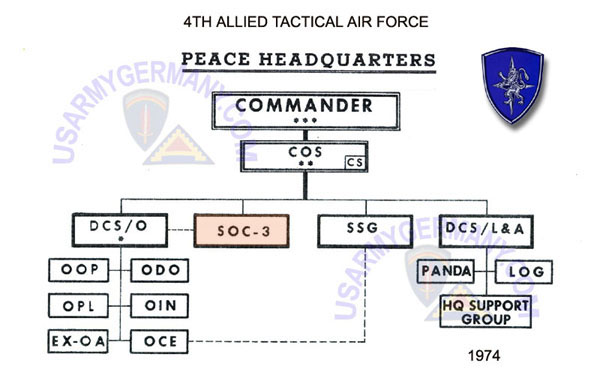 Peacetime Organization of 4th ATAF, 1974 |
|||||||||||||||||||||||||||||||||||||||||||||||||||||||||||||||||
| 1974 | |||||||||||||||||||||||||||||||||||||||||||||||||||||||||||||||||
| (Source: Diego A. Ruiz Palmer, HQ NATO) | |||||||||||||||||||||||||||||||||||||||||||||||||||||||||||||||||
| NATO CENTRAL REGION AIR DEFENSE COMMANDS | |||||||||||||||||||||||||||||||||||||||||||||||||||||||||||||||||
|
|||||||||||||||||||||||||||||||||||||||||||||||||||||||||||||||||
|
|||||||||||||||||||||||||||||||||||||||||||||||||||||||||||||||||
| 11th Radio Relay Squadron | |||||||||||||||||||||||||||||||||||||||||||||||||||||||||||||||||
| (Source: Email from Charles E. Hargrave) | |||||||||||||||||||||||||||||||||||||||||||||||||||||||||||||||||
| The 11th Radio Relay Squadron was responsible for communications between HQ 4th ATAF and the 1st Canadian Air Div, (Metz), 1st French AF (Lahr, Germany) and 12th USAF (Ramstein, Germany) at least until Late 1957. I wonder what happened to it after that? I was a 1st Lt. Comunications Officer for the 11th Radio Relay Squadron from late 1954 til late 1957, under the command of Major Richard Flechsig. Other officers in the squadron were Lt. William Roy (deceased), Lt. Marvin Breaux (deceased) , Lt. Richard Cheney, Lt Brelsford, Captain Beck, and myself. The 11th Radio Relay Squadron headquarters was located at Trier, Germany, on the same base as HQ 4th Allied Tactical Air Force. Euren, a former German air base, was a small kaserne just 2 or 4 kms. outside of Trier, on the road to Luxembourg. We provided VHF links to the 12th US Air Force at Ramstein AB, also to the 1st Canadian Air Division at Merci le Metz, and a link to the 1st French Air Force at Lahr, Germany. I was responsible for the link to the French, by maintaininng relay stattions in Alsace Lorraine. The largest of my stations was in Niederbronn-les-Bains, France (northwest of Haguenau, Fr.). To get the VHF signal to the German sites we had several relay stations in France. At the time I was there Alsace Lorraine was French, although over the years it went back and forth from France to Germany, and then to France again. It was a very responsible job for a guy only 21 years old. Didn't bother me then but as I look back on it, I get the shivers. One addition, just before I left in late 1957, the 11th Radio Relay Squadron went out of business, and the communications was maintained by some communications squadron. Don't remember the exact name and don't recall much about it. I was transferred to another building and didn't have much to do for a couple of months until I came back to the States. It was a sad ending to a tour of duty that was so important in the Cold War, so meaningful to me and such a challenge, and at the same time was a fun time in my life. (Webmaster note: one detachment of the 11th was at Metz, France) |
|||||||||||||||||||||||||||||||||||||||||||||||||||||||||||||||||
| Air Defense Operations Center / TACC / SOC | |||||||||||||||||||||||||||||||||||||||||||||||||||||||||||||||||
| ADOC Kindsbach | |||||||||||||||||||||||||||||||||||||||||||||||||||||||||||||||||
| (Source: Kaiserslautern American, March 12 2004) | |||||||||||||||||||||||||||||||||||||||||||||||||||||||||||||||||
|
|||||||||||||||||||||||||||||||||||||||||||||||||||||||||||||||||
| The center was a state-of-the-art 67-room, 37,000-square foot facility where USAFE could’ve lead an air war against the Soviet Union. The center had a digital “computer” to work out bombing problems, cryptographic equipment for coded message traffic and its own photo lab to develop reconnaissance photos. Responsible for an air space extending deep behind the Iron Curtain, the center interacted directly with the Pentagon, NATO, Supreme Headquarters Allied Powers Europe and all USAFE bases. With its massive telephone switchboard and 80 teletype machines, the cave was plugged into everything in the outside world. The center was receiving more than 1,000 calls a day. As a further measure of protection, the cave was fully self-contained with its own water supply, electric backup-generators, climate controls, dining facilities and sleeping accommodations for its 125-man crew. Visitor passes were rarely issued to this secret facility. |
|||||||||||||||||||||||||||||||||||||||||||||||||||||||||||||||||
|
|||||||||||||||||||||||||||||||||||||||||||||||||||||||||||||||||
|
|||||||||||||||||||||||||||||||||||||||||||||||||||||||||||||||||
| I mostly remember the middle tier since that is where the Projection Control Console was located. My job was to operate the PCC which displayed a dynamic picture -- through a projector call a "light valve” -- of all European traffic on a 40’ x 40’ screen overlaid with a map of |
|||||||||||||||||||||||||||||||||||||||||||||||||||||||||||||||||
| (Source: Email from Dick Boivin, 412L Maintenance Officer, 4th ATAF ADOC, 1962-64; CO CFMF, 1964-1965) | |||||||||||||||||||||||||||||||||||||||||||||||||||||||||||||||||
| As a young USAF Capt, I was assigned as the 412L Maintenance Officer at the 4th ATAF ADOC in the "cave" at Kindsbach in Aug 1962 after finishing a 6 weeks 412L systems course at GE in Syracuse. Our unit was a detachment of the 86th Air Division at Ramstein. When I arrived the air defense operations personnel were working using a small manual plotting board. This was interesting in that due to the room restrictions ( 412L being installed ) the plotters were in front of the plexiglass board instead of behind it and quite often, out of old habits, they started writing backwards on the front of the board. At that time GE was finishing the installation. We had only about a 3rd of our USAF maintenance troops there and the GE folks were providing some limited training to us on an as available basis. I too remember we had trouble with the"light valve" used to project the big screen picture. This was in the early computer days and memory was limited. The Surveillance Technicians had to convert track and speed data etc to octal format in order to enter anything manually into the system. Kindsbach was the first site to have its individual acceptance test completed and the old USAF GEEIA organization did most of that in 1963, with the paperwork being signed at the Palast hotel in Dec of that year. The Centralized Field Maintenance Facility ( CFMF ) was initially run by GE at Ramstein AFB. They repaired all the printed wire boards (PWB's) and electronic assemblies from all 412L sites. At some point around Aug 1964, the Air Force gave a maintenance contract to another company ( RCA, I think ) and I was given 2 weeks to transfer to a new job as Commander of the CFMF which was officially titled as Detachment 3 of the 601st ACW Sq at Birkenfeld. This was only on paper as I reported directly to the 86th AD CC. Each of the field sites had to give up about 4 experienced maintenance and immediately re-assign them to the CFMF. Fortunately for me one of them was a top notch Master Sgt whose last name was Burt. A deal was worked with GE where 4 of their experienced people would stay on work with us as we trained our people in this function. At the 412L sites, maintenance was based primarily on a remove and replace PWB and Sub-Assembly basis. We repaired about 1200 to 1400 PWB and about 75 assemblies per month and shipped them back to the 412L sites to use again. We stayed at about that level of repair until I left in Aug 1965. ADDITIONAL INFORMATION LAYOUT OF 4ATAF ADOC (KINDSBACH CAVE) As you went in the front entrance, you followed one of the tunnels around to the left and then back up toward the front. So as you looked at the front of the cave entrance, the 4th ATAF ADOC (412L area) was to the left. As you came in the hallway to the 4th ATAF ADOC (412L area), the "no break" back up power was in a small room on the left. This was a large electrically driven flywheel connected by straight shaft to a small diesel engine generator vented to the outside. In the event of a power outage the flywheel would drive the generator until it also started the diesel engine so the equipment would not see a power interruption as this would cause loss of main memory. This smaller generator only kept the computers and consoles going until a larger diesel/generator combination located outside the cave got started to provide sufficient power for all the 412L area. Continuing down the hall on the left was the 412L equipment room which contained the computer and all the main equipment racks. I remember this very vaguely but believe it was about 75x50 ft. I could be wrong on the size of all these rooms. This equipment was cooled by running a very cold brine solution through pipes in the cabinets as a coolant. This cooling system was not on the small "no break " generator and the equipment could only run about 10 minutes without overheating. Our back up to this cooling system was to just run cold water from a well through the system and let the discharge out into a sewer drain outside the cave. This sufficed to the main back up generator provided enough power to run the regular brine system. On the right side of the hall across the hall from the equipment room was the main 4th ATAF ADOC area with all the consoles and the large scale display. There was ( again this is a questionable memory ) only about 10 to 15 consoles. As I recall we had only Surveillance, and ID consoles with no Weapons Control consoles which were at the sites with radars. All our info was "cross tell" from the other sites. The Large Scale Wall Display was in front of the consoles and about 20x20 ft as I remember. The infamous "light valve" projector was behind the other consoles toward the rear of the room. At the rear of the room was a second floor which housed the ADOC battle staff. It was about 20x30 with of course a glass front to view the large scale projected display. There was the usual assortment of telephones and links to radios as well here. Back on the first floor behind the room where the consoles were located was the Electronic Switching Center (ESC) built by Northern Electric. At least when we first went operational, this served primarily the ADOC. The TACC still had there own system switchboard. We had only 2 or 3 offices, a supply room for 412L spares, and a couple of miscellaneous rooms. One of the miscellaneous rooms contained an exhaust hood workbench that was solely for the purpose of cleaning the light valve parts that were in contact with the oil bath used in projecting the large scale display as oil contamination was a frequent problem. 412L MAINTENANCE OFFICE The main office for managing the 412L system was in the 86th Air Division HQ buildings at Ramstein on the south part of the base near the runway. The 412L was managed by the 86th Air Division Comm-Elec staff. The 412L Consolidated Field Maintenance Facility (CFMF) was also located on Ramstein but not in the 86th Air Div general area. The CFMF was originally called the 412L Ffield Depot. ROLE OF MAINTENANCE OFFICER AT 4ATAF ADOC Responsibilities were basically maintenance of all the 412L equipment and operation and maintenance of the Electronic Switching Center (ESC). We had 4 maintenance crews that provided the seven-day 24-hour maintenance coverage. We used the standard ( at the time ) AF Manual 66-1 maintenance tracking system. As time went on we set our own stock and other spare parts levels based on turn around time at the CFMF. We did not repair printed wire boards ( PWB's) or 412L sub assemblies as these were repaired at the CFMF. The maintenance was for the most part trouble shooting and remove and replace. We devised and implemented our own ADOC maintenance OJT program as our site was unique. |
|||||||||||||||||||||||||||||||||||||||||||||||||||||||||||||||||
| 1965 | |||||||||||||||||||||||||||||||||||||||||||||||||||||||||||||||||
| (Source: Email from Dick Walker, 2135th Comm Sq, 1965-67) | |||||||||||||||||||||||||||||||||||||||||||||||||||||||||||||||||
| I was stationed in Germany with the USAF for 3 years (1965 to 1968..... 2 years at Ramstein, and one year at Hahn). I was a Crypto Maintenance guy (AFSC: 30650C) while at Ramstein with the AFSC's 2135th Comm Squadron, then with the 2184th at Hahn. My 2 years at Ramstein was basically spent working at the Kindsbach "Cave." We crypto guys were somewhat familiar with the 412L System, since we had to make our daily security changes on the crypto equipment located in the 17th AF COC Commander's quarters located above the ground floor and directly in view of the giant display screen. We got to know a couple of the 412L guys at the time, but their names now escape my memory. It was amazing to view the Cold War games.... unidentified red markers representing aircraft on the screen, turn to green when they were determined to be friendly aircraft. It was also interesting to see the red markers turning back and heading east when our planes intercepted and chased them back. The Soviets would continually challenge the airspace of West Germany's eastern border, and of course our aircraft were always up for the challenge. Although I didn't realize at the time; but those days were really special, as I have many fond memories of the people: (Skidmore, Sudreth, Wooldridge, Alford, Billiter, Jones, and Zill), and the places where I worked. |
|||||||||||||||||||||||||||||||||||||||||||||||||||||||||||||||||
Ramstein at the time, had a Base Communications Center in a small building, directly across from an multiple floor L-shaped building that housed 17th Air Force Headquarters. Base Comm had a switchboard, and I'm guessing the Cave did too. I know there were additional communications capabilities and facilities inside the Cave; but the units had their own secured areas, and we had no "need to know" what went on at those places. |
|||||||||||||||||||||||||||||||||||||||||||||||||||||||||||||||||
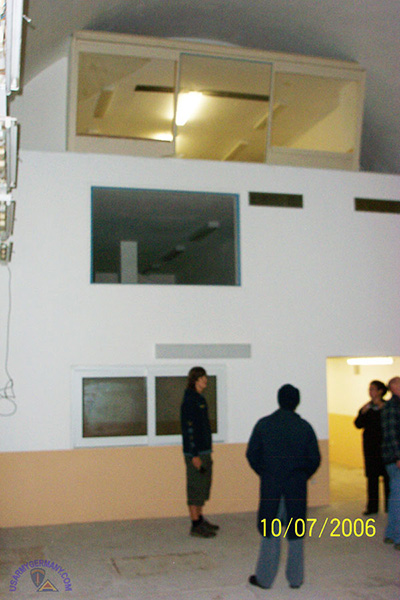 Operations Room in the Kindsbach Cave, 2006 |
|||||||||||||||||||||||||||||||||||||||||||||||||||||||||||||||||
| The photo above shows the Kindsbach Operations Room in 2006 (source: Dr. William Elliott, HQ USAFE). The top room (with the lights on) was an addition that was added after I left Ramstein in 1967. The old War Room was the one on the 2nd floor in the 2006 photograph. Brings back good memories. ADDITIONAL INFORMATION The 2135th Comm Squadron wore the AFCS patch, as did (I'm fairly certain) all of the other Communication Squadrons in Europe. We were bussed to the Kindsbach site in one of those small Air Force dark blue school buses, that ran continuously every half hour between Ramstein and Kindsbach. After hours, if you missed the bus, or got called in, you had to notify base transportation, and then you were chauffeured to the site by a German civilian driver in a Air Force station wagon. And, for what it's worth, the white sign near the entrance door parking spot to the Kindsbach "Cave" (see photo at top of post), reads: "RESERVED FOR COMMANDER 17th AIR FORCE." |
|||||||||||||||||||||||||||||||||||||||||||||||||||||||||||||||||
|
|||||||||||||||||||||||||||||||||||||||||||||||||||||||||||||||||
| (Source: Email from Robert Jordan, Kindsbach COC (Det 1, 615th AC&W, 1972-74) | |||||||||||||||||||||||||||||||||||||||||||||||||||||||||||||||||
|
|||||||||||||||||||||||||||||||||||||||||||||||||||||||||||||||||
| I don't recall ever hearing the term D-Area, or Z as mentioned on your page. We just referred to it as the operations room or SOC (Sector Operations Center), if I recall correctly. The 2nd floor was strictly radar operations with the two large consoles across from each other. With exception to the French Liaison, and I never really figured out why they were there except as simply "liaison" as the term applied. Just in case we had to deal with flight issues over France, I suppose. I was good friends with two of them, and spent several weekends visiting with them and their families in off time. The consoles were part of the 412L system and radar display consoles. Individual switches or buttons allowed for filtering of types of radar detail, along with enlargement of certain areas. Our jobs, as 276xx radar operators, was pretty boring at Kindsbach. We were just there to oversee traffic throughout the 4ATAF's area of responsibility. We did not control flights, and it was very similar to my job in Vietnam at Motel, on Monkey Mountain near DaNang. That was the TACC-NC (Tactical Air Command Center - North Sector). We watched, warned, and plotted traffic. The same occurred at KUF. Other dets were control sites, not us. Below the 2nd floor is where the shift commander, and any other officers or visiting brass, would sit. Most of my time was spent, when we were not playing war games, playing endless games of cards, reading, studying for APRs....etc. |
|||||||||||||||||||||||||||||||||||||||||||||||||||||||||||||||||
|
|||||||||||||||||||||||||||||||||||||||||||||||||||||||||||||||||
|
|||||||||||||||||||||||||||||||||||||||||||||||||||||||||||||||||
| SOC-3 Langerkopf, Germany; Börfink, Germany | |||||||||||||||||||||||||||||||||||||||||||||||||||||||||||||||||
| (Source: STARS & STRIPES, Oct 7, 1963) | |||||||||||||||||||||||||||||||||||||||||||||||||||||||||||||||||
| Voices in a Dark Room If an unknown aircraft enters the airspace of the Federal Republic of Germany, probably the first man to sound the alarm will be sitting in a dark room, surrounded by the low hum of electronic equipment and a subdued babble of voices speaking French, German and English. This man is a radar air surveillance operator and his job is one of the least known yet most demanding in all the Air Force. He -- along with dozens of other specialists -- will be working in one of the air defense units which protect NATO countries from air attack. One such unit is the 86th Air Div's 603rd Aircraft and Warning Sq at Langerkopf, near Ramstein Air Base, Germany. The 86th has three other air division radar units in Allied Sector III, but operationally, the 603rd is the controlling agency and focal point for all information. Allied Sector III together with Allied Sector IV to the south make up the 4th Allied Tactical Air Force (4th ATAF) area of defense responsibility in Central Europe. |
|||||||||||||||||||||||||||||||||||||||||||||||||||||||||||||||||
|
|||||||||||||||||||||||||||||||||||||||||||||||||||||||||||||||||
| The SOC requires such intense concentration that its controllers and technicians work only short periods before being relieved for a break. There's a peacetime aspect of the SOCs that makes them popular with the pilots of all nations -- that's the help the technicians give aircraft in trouble. Since 1957, the radar net of the 86th Air Div has saved well over 100 aircraft which without help from the radar net would have been abandoned. The most common problem Is radio and navigational equipment failure. One pilot in trouble wrote "Hahn" in the frost of his cockpit window, and an interceptor pilot promptly led him to his home base. Col Winton W. Marshall, sector commander, commented: "You could say that the Sector Operations Center functions along the lines of a big computer, except that we use men instead of electrical circuits. You must also consider that we are working with three languages ourselves, in addition to the languages spoken by the pilots who fly through our sector. "Of course, we have many problems. Some of these will be solved through the introduction of our new radar system, 412-L, similar to the SAGE system in the United States. Some of them will always be with us, such as the tension associated with the mission itself, the need for better technicians as our systems become more complex and the burden of split-second decisions forced by faster-reaction weapons, both offensive and defensive. "Despite these problems, I feel that the men in the SOC and throughout the 86th Air Div and allied units under SOC control are doing a magnificent job in providing an effective air defense system in this vital sector of Central Europe," he said. Allied Sector III is co-located with a Missile Control Center of the U.S. Army. The Nike-Hawk surface-to-air missile system is an important complement to the air defense capability of Allied Sector III and NATO as a whole. The 603rd is the vital link in the Army-Air Force chain of operations. Langerkopf SOC wears two hats -- it's tied to both the United States Air Force and to the NATO defense setup and conducts normal day-to-day operations under both chains of command. In the unlikely event of the United States taking unilateral action, the 86th Air Div would make use of its complex of ground radar and supersonic interceptors spread over the Federal Republic of Germany under USAFE. More probably, an attack on one NATO nation would be considered an attack on all, and the division units would operate under the NATO concept of air defense, involving ground and airborne forces of member nations welded into a single force. "Air defense is a complex and demanding mission:" Brig Gen. F. W. Gillespie, 86th Air Div commander said. "Perhaps it lacks the spectacle of a missile launch, but, unlike the missile, air defense can be actively used to keep peace as well as wage war. As long as we can use manned interceptors to visually identify unknown aircraft the free world will not be faced with a 'go' or 'no go' decision based only on radar returns. "Man is still our most dependable weapone system." (Would appreciate feedback from former members of any of the USAFE ACWS units during the 1950s-70s who can provide additional details on the Sector Operations Center (III and IV) and the various CRC operations centers in the 4th ATAF sector of southern Germany - please contact me |
|||||||||||||||||||||||||||||||||||||||||||||||||||||||||||||||||
| (Source: STARS & STRIPES, Dec 31, 1971) | |||||||||||||||||||||||||||||||||||||||||||||||||||||||||||||||||
| 412L Air Defense System at Börfink An overhaul project of the computerized electronic equipment of the 412L system at the underground Boerfink bunker (SOC-3) was recently completed. Ten different units were involved in the more than 3-month effort. The electronics facility was turned over in November to the operational unit at Boerfink, the 615th Aircraft Control & Warning Sq, and put back into full operational status. The overhaul tasks performed included repair of computer cabinets, replacement of power and signal wiring as well as replacement of other electronic and computer components. Units involved included maintenance personnel of the 615th; the 1836th Electronics Installation (EI) Sq (1); 1829th EI Sq (Griffis AFB, NY); 1833rd EI Sq (McClellan AFB, Calif); 1839th EI Gp (Keesler AFB, Miss); 1969th Comm Sq (South Ruislip, England); 2063rd Comm Sq (Wiesbaden); 2134th Comm Sq (Sembach); 2139th Comm Sq (Bitburg); 1945th Comm Sq (Rhein-Main). In addition to the military units, civilian tech reps from the General Electric Company were also involved. (1) The 1836th EI Squadron is the only unit of its kind in Europe. It is responsible for the installation and maintenance of ground electronics equipment (radar, radio, microwave, telephone, teletype, navigational and weather aids and antenna systems) for the Air Force and NATO in an area that stretches north to south from the Arctic Circle to Central Africa, and west to east from Spain to Pakistan.) |
|||||||||||||||||||||||||||||||||||||||||||||||||||||||||||||||||
| SOC-4 Drachenbronn, France; Messtetten, Germany | |||||||||||||||||||||||||||||||||||||||||||||||||||||||||||||||||
| (Source: Email from Aurélien Poilbout , France) | |||||||||||||||||||||||||||||||||||||||||||||||||||||||||||||||||
|
|||||||||||||||||||||||||||||||||||||||||||||||||||||||||||||||||
| ADDITIONAL INFORMATION Besides Gen Risso mentioned above, there were other senior officiers who were very important in the relations between the French Air Army and NATO. Here are a few of the: - General Stehlin, commandant of 1er CATAC (1956 - 1958), then chief of staff of Air Army, "Chef d'Etat Major de l'Armée de l'Air" (CEMAA) - General Raymond Brohon, member of Standing Group, second to Norstad, SACEUR, commandant at Suez Operation, commandant of 1er CATAC (1958 - 1960) - Gen Accart, cdt of 1er CATAC (1960-1962), then he was the chef of expert who created NADGE since 1965 to 1967. - Gen Maurin, cdt of 1er CATAC (1962-1964), where nuclear-capable F100's are entering the French services, cdt of Forces Aériennes Stratégiques, FAS on Mirage IV, then CEMAA. - Gen Forget, cdt of 1er CATAC in 1980s The first two, Stehlin and Brohon, represented the Atlantic trend in Air Army. That is the reason why Brohon never become CEMAA. Lots of officiers were more focused in the Algerian war, like Jouhaux or Challe, putschist in 1961. Maurin become CEMAA because he was competent in nuclear questions after he stay next americans teachers. Gen Forget had a lot of relations with 4e ATAF after France left NATO. He is still alive and he wrote a lot of books where he referred to relations Air Force and NATO. Of course, you know Gen Gallois, one of the "Hot colonels", like Richardson, who under Norstad, SACEUR, theorised the "massive retaliation". He was employed by Dassault Industry and was a proponent of french nuclear independance. |
|||||||||||||||||||||||||||||||||||||||||||||||||||||||||||||||||
| (Source: Various sources) | |||||||||||||||||||||||||||||||||||||||||||||||||||||||||||||||||
| An air defense radar site was established at Drachenbronn in 1952. In 1957, a Station Maitre Radar 50/921 was installed. In 1960, the Groupement de Contrôle Tactique Aériee N° 451 (GCTA) was stationed at Drachenbronn. (It appears that the Drachenbronn installation was designated as Air Base 901 at the same time.) Between 1963 and 1966, Drachebronn served as Allied Sector Operations Center 4 (Centre d’Opérations du Secteur Interallié N° 4) under 4th ATAF. (Commander of SOC-4 from 1963 to 1965 was Gen Joseph Risso, FAF.) In 1964, Drachenbornn was the first French radar site to be equipped with the STRIDA II air defense system (developed by Alcatel) -- noticed that the system was designated as Visu II. |
|||||||||||||||||||||||||||||||||||||||||||||||||||||||||||||||||
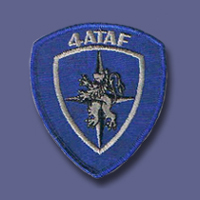
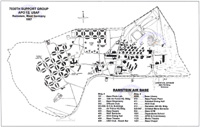
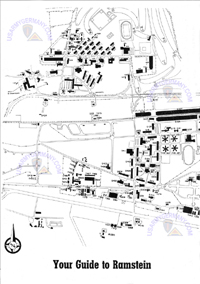
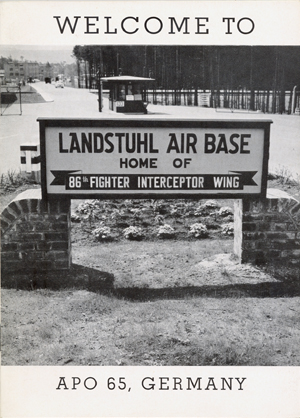
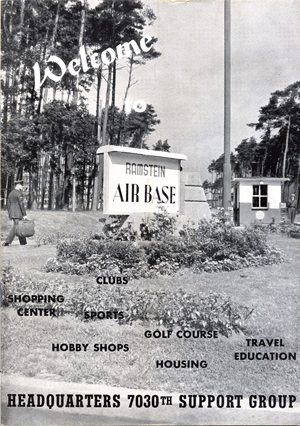
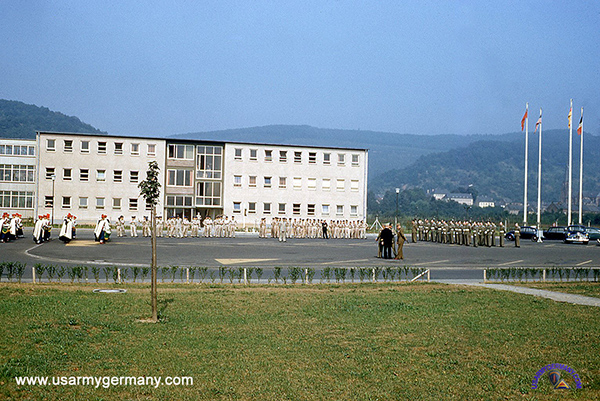
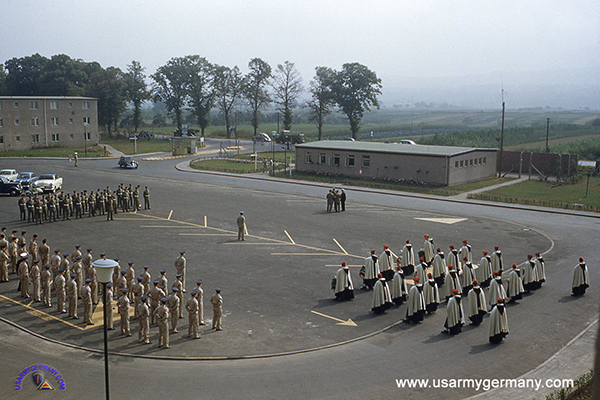
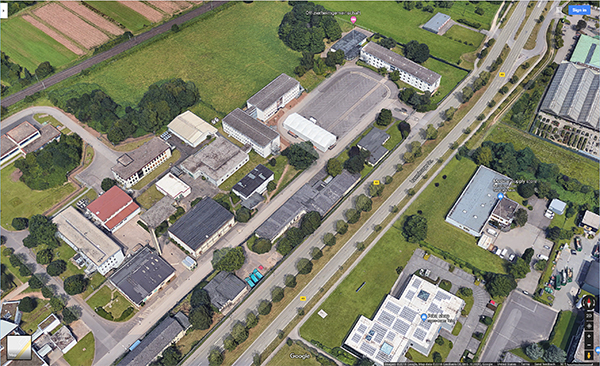
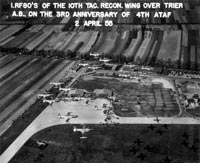
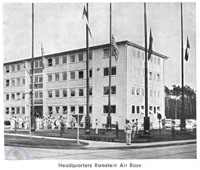
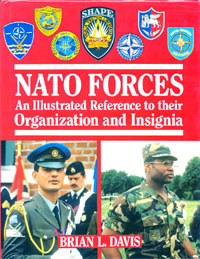
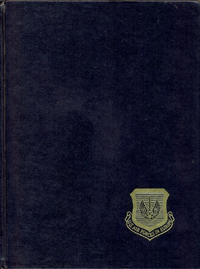
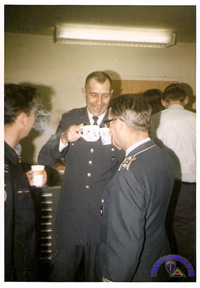
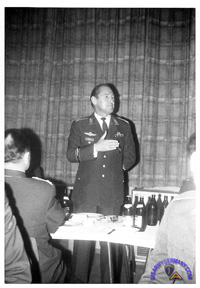
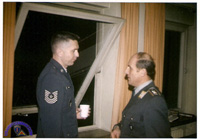
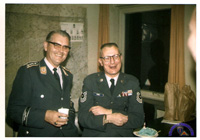
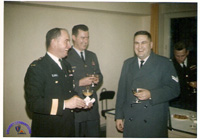
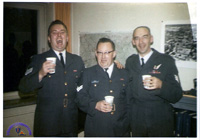
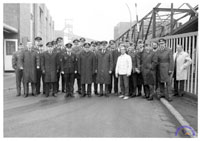
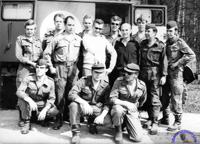
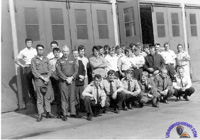
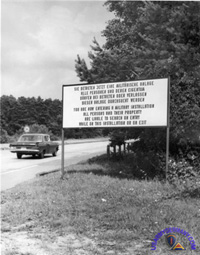
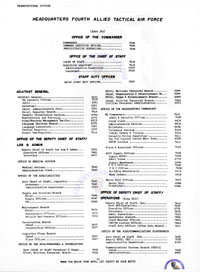
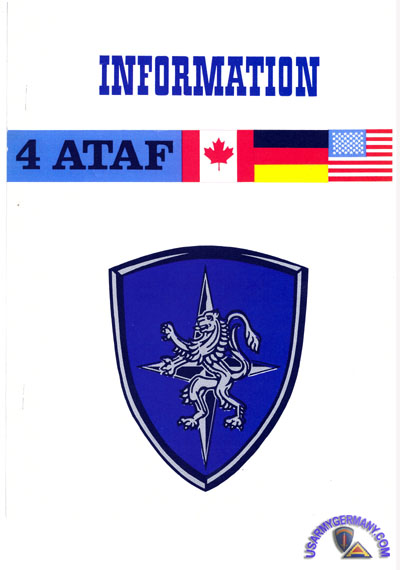
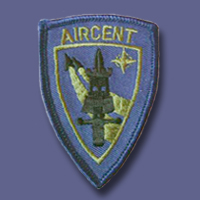
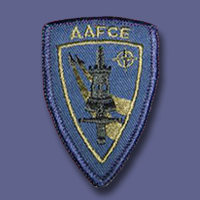
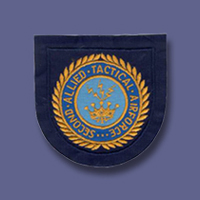
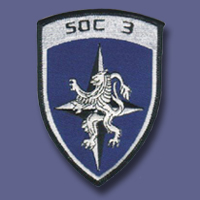
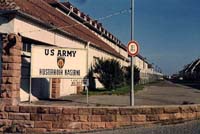
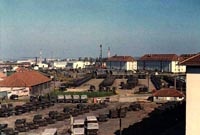
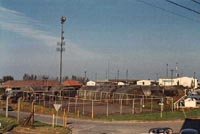
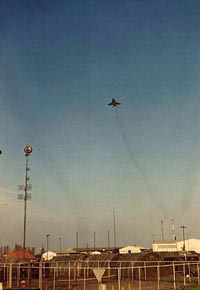
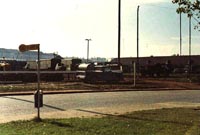
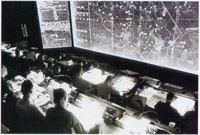
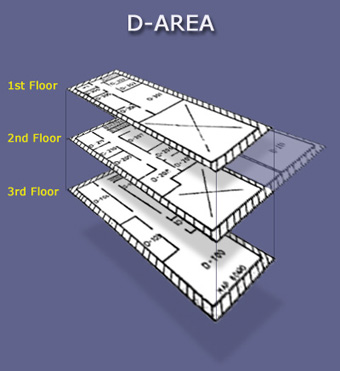
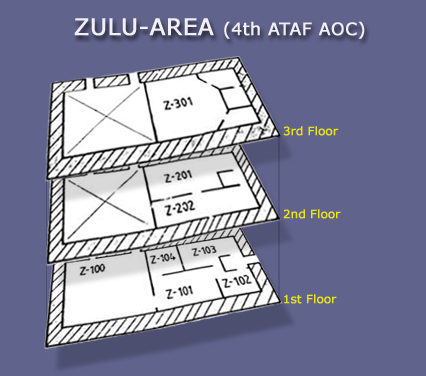 Zulu Area - original Operations Room (Manual Era)
Zulu Area - original Operations Room (Manual Era) 